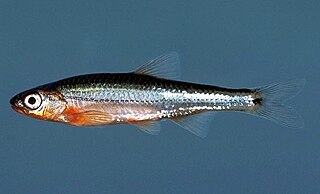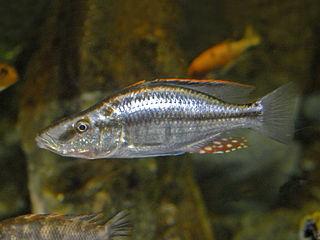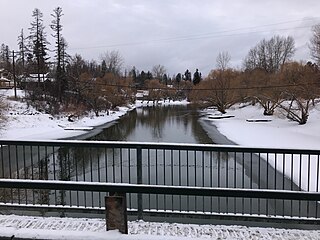
The bluegill, sometimes referred to as "bream," "brim," "sunny," or, as is common in Texas, "copper nose", is a species of North American freshwater fish, native to and commonly found in streams, rivers, lakes, ponds and wetlands east of the Rocky Mountains. It is the type species of the genus Lepomis, from the family Centrarchidae in the order Perciformes.

The yellow perch, commonly referred to as perch, striped perch or preacher is a freshwater perciform fish native to much of North America. The yellow perch was described in 1814 by Samuel Latham Mitchill from New York. It is closely related, and morphologically similar to the European perch ; and is sometimes considered a subspecies of its European counterpart.

The Quesnel River is a major tributary of the Fraser River in the Cariboo District of central British Columbia. It begins at the outflow of Quesnel Lake, at the town of Likely and flows for about 100 kilometres (60 mi) northwest to its confluence with the Fraser at the city of Quesnel.

The lake chub is a freshwater cyprinid fish found in Canada and in parts of the United States. Of all North American minnows, it is the one with the northernmost distribution. Its genus, Couesius is considered monotypic today. The genus was named after Elliott Coues, who collected the holotype specimen.

The mountain whitefish is one of the most widely distributed salmonid fish of western North America. It is found from the Mackenzie River drainage in Northwest Territories, Canada through western Canada and the northwestern USA in the Pacific, Hudson Bay and upper Missouri River basins to the Truckee River drainage in Nevada and Sevier River drainage in Utah.

The Tennessee shiner is a species of fish in the family Cyprinidae, the carps and minnows. It is native to the southeastern United States.
The Tennessee dace is a species of ray-finned fish in the family Cyprinidae. It is found only in the United States; particularly in northeast Tennessee and southwest Virginia, and parts of extreme northwest Georgia. Until recently, they were considered a subspecies of mountain redbelly dace. They are commonly found in East Tennessee in spring fed first-order streams, often in silt and fine gravel pools, or undercut banks. These streams usually do not exceed two meters in width.

The Malawi eyebiter is a species of fish in the family Cichlidae. This predatory cichlid is endemic to Lake Malawi in East Africa.

The hornyhead chub is a small species of minnow in the family Cyprinidae of order Cypriniformes. It mainly inhabits small rivers and streams of the northern central USA, up into Canada. The adults inhabit faster, rocky pools of rivers.

Semotilus atromaculatus, known as the creek chub or the common creek chub, is a small minnow, a freshwater fish found in the eastern US and Canada. Differing in size and color depending on origin of development, the creek chub can usually be defined by a dark brown body with a black lateral line spanning horizontally across the body. It lives primarily within streams and rivers. Creek chubs attain lengths of 2–6 inches (5.1–15.2 cm) with larger specimens of up to 12 inches (30 cm) long.

The Whitefish River is a 24.8-mile-long (39.9 km) southward-flowing stream originating at the outlet of Whitefish Lake. The river is a tributary of the Stillwater River just before it reaches the Flathead River in Flathead County, in the U.S. state of Montana. The Whitefish River is part of the Columbia River basin, as the Flathead River is a tributary of Clark Fork, which is a tributary to the Pend Oreille River, which is a tributary to the Columbia River.

The spottail shiner or spottail minnow is a small- to medium-sized freshwater minnow. It can be found as far north as Canada and as far south as the Chattahoochee River in Georgia. These shiners live in lakes, rivers, and creeks. They occupy the rocky or sandy shorelines and bottoms of the water. One of the defining features of a spottail shiner is the black spot found at the base of the caudal fin. These shiners generally spawn from late June through July.

Silverjaw minnows are part of the family Cyprinidae, which includes carps and minnows. With over 300 known species, there are more species of minnows native to North America's fresh waters than any other fish. Minnows can be hard to distinguish because many look alike. All minnows have one dorsal fin, ventral fins near the anus, a lateral line system, and smooth, round cycloid scales. Their jaws lack teeth, but they have one to three rows of pharyngeal teeth to grind food. Defining physical characteristics such as the number and type of fin rays, type of scales, and pattern of pharyngeal teeth are used to distinguish minnows.

The Chihuahua shiner is a species of freshwater ray-finned fish from the family Cyprinidae, the carps and minnows. It is found in southern Texas and northern Mexico.

Mylopharadon conocephalus, known as the hardhead, is a freshwater ray-finned fish from the family Cyprinidae, the carps and minnows, which is endemic to California. It is the sole member of the monotypic genus Mylopharadon.
The plains minnow is one of the 324 fish species found in central United States. It is a large minnow that was once a common bait fish. The plains minnow requires shallow, slow-moving streams to complete its life cycle. Pollution, dams, and introduced sport fish have caused populations to decline.
The river chub is a minnow in the family Cyprinidae. It is one of the most common fishes in North American streams.

Somenos Lake is a small shallow water body located in the Municipality of North Cowichan on Southeast Vancouver Island. Somenos Lake has a maximum area of approximately 247 ac, 100 ha at 15.3 feet (4.7 m) above geodetic datum. The Lake is relatively shallow with a maximum depth of 22.2 feet (6.8 m). Somenos Lake is fed by three major tributary streams: Richards Creek from the North and Northeast, Averill Creek from the Northwest and Bings Creek from the West. The lake is drained near its southern extremity by Somenos Creek which flows southeast approximately 4 kilometres (2.5 mi) to the Cowichan River.

Whitefish Lake ; is a natural oligotrophic freshwater lake in Flathead County, Montana, United States.


















